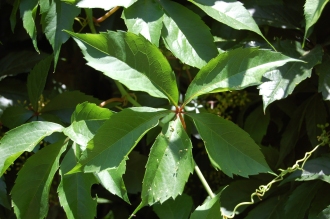Position: Full sun to partial shade
Soil: Well drained
Flowering period: Late Spring/Early Summer
Eventual Height: 30m
Eventual Spread: 8m
Hardiness: 3a, 3b, 4a, 4b, 5a, 5b, 6a, 6b, 7a, 7b, 8a, 8b, 9a, 9b
Parthenocissus quinquefolia is a woody vine and a prolific climber. It has palmately compound leaves composed of five leaflets with toothed margins joined by a central point on the leafstalk. They range from 3 to 20 cm across and have a toothed margin. This vine climbs smooth surfaces by means of small forked tendrils tipped with strongly adhesive pads 5 mm in size. Its hermaphrodite flowers are small and greenish, produced in clusters in late spring, maturing in late summer and early autumn into small hard black berries. The leaves of this climber turn a deep red before the laves fall of the plant in autumn.
Parthenocissus quinquefolia, commonly known as Virginia Creeper, is native to eastern and central North America, southeastern Canada, Mexico and Guatemala. This species of vine is often mistaken for the Parthenocissus vitaceae which has the same leaves but does not have the adhesive pads on the end of its tendrils. Parthenocissus quinquefolia, similar to Parthenocissus tricuspidata, will provide effective solar shading for south facing masonry walls on buildings. It will not harm the fabric of the masonry as it clings via adhesive cups rather than penetrating roots. However care should be taken when removing this plant from the wall, sections should be killed and allowed to die before being removed.
The etymological root of the binomial name Parthenocissus is derived from the Greek parthenos meaning ‘virgin’ and kissos meaning ‘ivy’. Quinquefolia is derived from the Latin meaning ‘five leaves’.
The UK landscape architect should not specify Parthenocissus quinquefolia in the UK as it has been added to Schedule 9 of the Wildlife and Countryside Act 1981 in 2010. This plant was useful to the landscape architect as an effective self clinging deciduous climber with good autumn colour. It could have been used as shading to reduce solar gain on the south elevations of buildings.
Ecologically, Parthenocissus quinquefolia will attract many species of pollinating insects such as honey bees and butterflies. Its berries are a valuable source of food for birds during the winter months.
Parthenocissus quinquefolia prefers moist but well drained soil conditions. It prefers soils with a pH between acid and alkali. It prefers a soil with particle sizes between sand and clay.
The Royal Horticultural Society gave Parthenocissus quinquefolia their prestigious Award of Garden Merit in 1993.
Parthenocissus quinquefolia will require support until established. It may be pruned in winter or if required in summer to restrain its growth in unwanted areas.
![]()
Landscape Architecture













